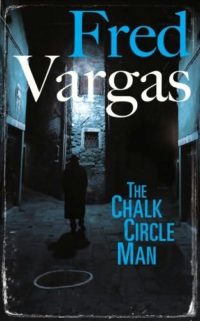Now he had a decanted version of his thoughts, organised by gravity
 The Chalk Circle Man
The Chalk Circle Man
by Fred Vargas
translated from French by Siân Reynolds
This is my France selection for the EU Reading Challenge. It’s a detective novel set in Paris that was recommended years ago on The Readers podcast (RIP). I do tend to prefer crime novels written by women (Fred is short for Frédérique in Vargas’ case) and I think that crime/detective fiction is often especially strong on setting/sense of place. I’m grateful for the recommendation, even if it has taken me a long time to follow up on it.
This is the first in a series of novels following Commissaire Jean-Baptiste Adamsberg. He is already an established, successful public figure thanks to solving some big, media-friendly cases in the Pyrenees. New to Paris and the 5th arrondissement, he is not trying particularly hard to fit into his new team. He’s quiet, contemplative, often seeming to ignore his colleagues. He doesn’t seem to be the right temperament at all for detective work.
Adamsberg trusts his intuition more than seems advisable for someone in charge of major crime investigations, and he talks a lot about trusting these gut feelings and not logic. But I think this is to some extent a mask, as he is in fact extremely observant and has an excellent memory. He also has a high tolerance for other people’s quirks, for example quickly adapting to the discovery that his second-in-command, Danglard, is an alcoholic who is only just managing to hold it together as a single father to five children. He sees through the alcoholism to Danglard’s intelligence and abilities, and judges when to stay Danglard’s hand and when to let him drink.
“[Danglard] would have liked to borrow some of Adamsberg’s vagueness and uncertainty, the times when his gaze seemed to be dying or burning by turns… He thought that if he had Adamsberg’s gaze, he might see things start to wobble, to lose their clear reasonable contours, like trees shimmering in a summer heat haze. Then the world would seem less implacable to him, he would stop wanting to understand every tiny little detail about everything, exploring even the remotest areas of the heavens. He would feel less exhausted as a result. But as it was, only white wine enabled him to take his distance, for a brief and, as he knew, artificial moment.”
The investigation at the centre of this novel starts out as a matter of curiosity – not really a police matter but something that has Adamsberg worried. Someone has been drawing large circles in blue chalk around discarded items on Paris streets. The circles are drawn late at night and skip around between arrondissements. They’ve been turning up for months and newspapers are starting to show interest, but Adamsberg’s colleagues don’t understand his fascination.
Until, that is, his macabre prediction comes true and a dead body turns up in one of the circles. Are the two things linked? Or has a murderer taken advantage of the mystery of the blue circles? Which direction should Adamsberg’s investigation take?
“Adamsberg went for a walk until evening. It was the only way he had found to sort out his thoughts. As if, thanks to the exercise, his thoughts were being stirred, like particles in a suspension. That way, the heavier ones fell to the bottom and the more delicate ones floated to the top. In the end, he came to no conclusion, but at least now he had a decanted version of his thoughts, organised by gravity.”
Most of the characters in this novel are quirky but not irritatingly so. In addition to Adamsberg, there’s Mathilde, who has some strong opinions about days of the week, and likes to follow people and keep notes on them – which has some obvious uses to the police, though she is sparing with her assistance. Everyone really, including all the suspects, is painted in a light that makes them difficult to work out and even harder to trust.
Vargas has a poetic turn of phrase and plays with expectation versus reality, which is certainly intriguing and a little different for the detective novel. I am definitely interested in where Adamsberg’s story goes next.
L’Homme aux cercles bleu published 1996 by Editions Viviane Hamy.
This translation published 2009 by Harvill Secker.
Source: Amazon.